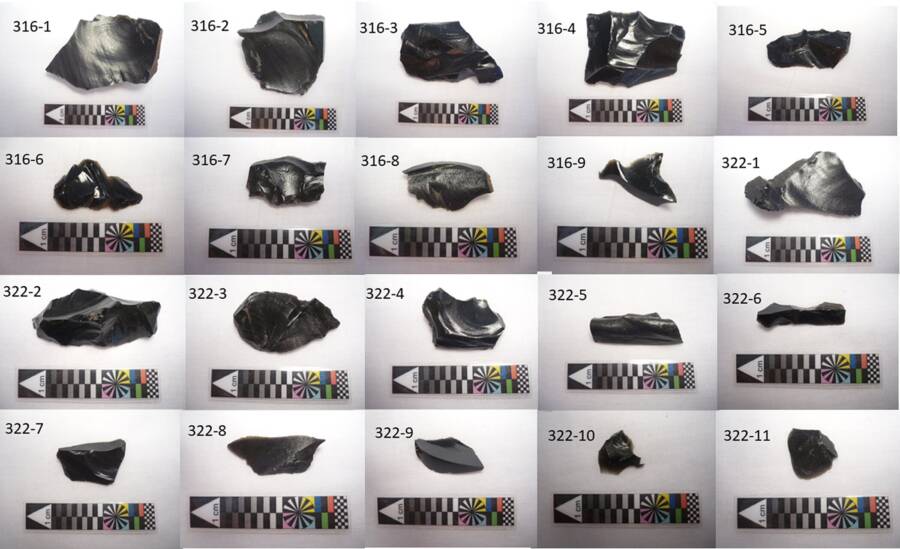Trace evidence of plants found on obsidian blades from Rapa Nui suggests the island maintained frequent contact with South America during the earliest years of its settlement.

Andrea SeelenfreundThe Anakena site on Rapa Nui as it looks today, after some restoration work.
Researchers have discovered ancient food remnants on obsidian blades recovered from Rapa Nui — also known as Easter Island. An analysis of the starch grains reveals that the island’s earliest settlers feasted not only on Polynesia’s native plants, but also on foods indigenous to South America, roughly 2,300 miles away.
The results of this study were published in the journal PLOS One. Now, these surprising findings could fundamentally change our understanding of ancient life on Easter Island.
Settlers Of Rapa Nui Made Frequent Trips To South America
The people of Rapa Nui, famous for the large stone Moai statues they carved, have a somewhat obscure history, largely due to the fact that much of it was passed along via oral tradition.
The study reports that Rapa Nui was first occupied sometime between about 1000 to 1300 C.E. Based on oral history, it was previously known that, on at least one occasion, the island’s earliest inhabitants had traveled to South America. However, the new study shows that these trips may have been more frequent than previously believed.
In 1987, archaeologists unearthed several obsidian blades at a site known as Anakena, the earliest known settlement on the island. As part of the new study, researchers analyzed 20 of the blades and found trace amounts of plant material.
This discovery verified that the blades had once been used to cut, scrape, and grate various plant-based foods.

Andrea SeelenfreundPieces of obsidian blades analyzed in the study.
By analyzing the starch grains, the researchers identified traces of cassava, breadfruit, purple yam, taro, sweet potato, achira, ginger, and the Tahitian apple. Some of the species, including yam and taro, were already known to have been cultivated on the island.
However, researchers also identified several taxa not previously known to have grown there. For instance, the Tahitian apple and breadfruit, while not native to Rapa Nui, are Polynesian crops, and were likely brought in from other islands.
Even more shockingly, ginger had never before been found in the remote parts of ancient Oceania. Cassava, sweet potato, and achira, meanwhile, are all South American foods.
This study provides direct evidence of the translocation of South American crop plants during the earliest stages of the settlement of Rapa Nui, about 1,000 years ago.
It’s likely that Rapa Nui’s earliest settlers made multiple trips to and from South America, where they brought back various fruits and vegetables, later cultivating them on the island itself by planting seeds.
What This Study Reveals About Life In Ancient Rapa Nui
“Our results show that, by the time that people were living at the Anakena site, they already had voyaged to the South American coast and been in contact with South American peoples,” study author Andrea Seelenfreund of the Academy of Christian Humanism University in Chile tells Live Science.
“We argue that Polynesian (Pacific) voyagers reached the coast of the American continent and interacted with local American populations and, at some later point, returned to the Pacific islands with some American crops that were then cultivated on different islands alongside traditional Pacific crops.”
It wasn’t until 1722, when Dutch explorers arrived at Easter island on Easter Sunday (hence the name), that its existence became known to the world at large. But the new study suggests that this might not have always been the case.
Moreover, the exact origins of the island’s original settlers have always been somewhat obscure, with some suggesting they came from South America, others from Polynesia, and some saying they perhaps came from both.
While the new study does not answer all of these questions, it does show that Rapa Nui was not always completely isolated.
Of course, more research is required to unravel all of Rapa Nui’s mysteries, though the study’s authors are optimistic that further studies could help illustrate the relationship between Rapa Nui’s inhabitants and the rest of the ancient world.
After reading about this new discovery from Easter Island, learn about Point Nemo, the most remote location on planet Earth. Then, learn all about 30 famous statues from around the world.





